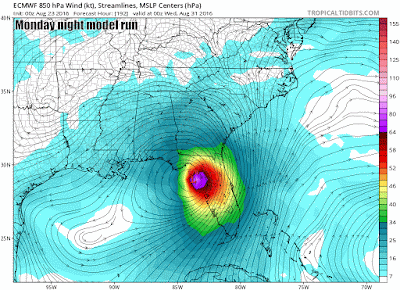We've got a pulse
We were almost ready to announce a time of death for '99L' on Thursday, but 18 years in this business and even more tracking systems like these have taught me things can change in a hurry in the tropics. We didn't see '99L' blow up into a tropical depression or storm today, but after a day devoid of any nearby convection (t-storms) on Thursday, blossoming t-storms on the eastern side of the system let us know it still has a pulse and a chance.
 |
| Satellite image from 2:30 PM Friday afternoon shows developing t-storms associated with 99L, primarily on its eastern flank (east of the 'L' on the map). |
Model guidance: not so fast, 99L
The last few runs of the European model have now come much more in line with the GFS and essentially keep '99L' as a tropical wave moving into the eastern Gulf and then have it drawn northward without much fanfare.
 |
| Morning model runs from Friday, Aug. 26 valid for 7 p.m. Tuesday, Aug. 30. Top panel (GFS) and bottom panel (European). Credit: WeatherBell |
Forecast uncertainty
I've struggled with two aspects of this forecast all along through the week. First, I couldn't understand why the GFS and then the Euro didn't have much becoming of '99L' even once it entered the Gulf of Mexico where conditions appeared to be more favorable for development. While it may not be the lone factor, additional analysis I've done today leads me to believe dry air on the western side of '99L' may continue to be a factor.
The other thing that bothered me was this forecasted turn to the north once it entered the eastern Gulf of Mexico. Most guidance was showing a fairly potent ridge of high pressure centered over the Southeast U.S. which would tend to keep the system trekking farther westward into the Gulf. However, I'm starting to believe the models are seeing a developing upper-low near Bermuda as a feature that will drift westward, weaken the ridge, and essentially help '99L' turn northward. This is a complex interaction for sure, so I still wouldn't take it as a given.
Bottom line
The latest outlook from the National Hurricane Center as of 1 p.m. Friday still gives '99L' a 60% chance of development within the next 5 days. Do not let your guard down. The good news is that most of our reliable guidance keeps '99L' to our east even if it does develop.
Please remember that forecast errors at 4-5 days and beyond can still be quite high, so this is not an all clear. It's just to say we're liking the trend for now but will continue to monitor its progress through the weekend.
A final note
For the last couple of days, I've seen many of my colleagues in the weather business calling any mention of '99L' hype or referring to it as the most hyped tropical disturbance in history. Yes, there are a few who have gotten out of hand, but for the most part, the amount of attention devoted to this underachieving tropical wave has been warranted.
Remember, we had very reliable guidance indicating the potential for a hurricane in the Gulf of Mexico, with some model runs indicating something close to a major (Cat. 3 or stronger) hurricane. I think it would be negligent on our part not to discuss the possible scenarios, particularly given the state that our region is in right now. I can promise you I will always discuss events like this in detail, with special attention paid to not over-hyping or unnecessarily scaring anyone.
The important thing is that we put everything in a proper context. Not only can this provide some useful information to you at home, but discussions like these can help spark good dialogues within the weather community on systems like '99L' that prove elusive to forecast.
Stay safe and here's hoping that the GFS and Euro are both right with not much becoming of '99L'.


















